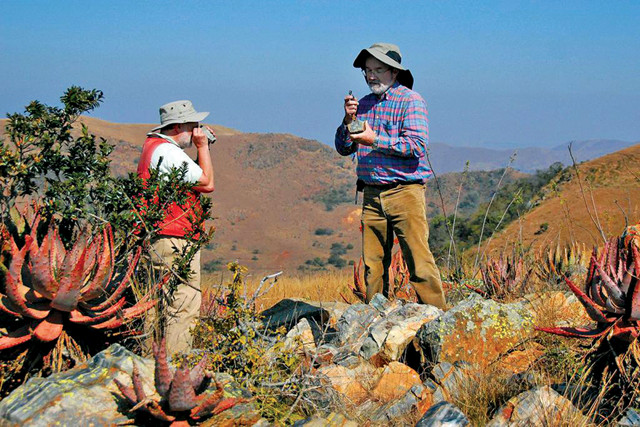
by Lucas Joel Monday, September 21, 2015

Donald Lowe and Gary Byerly examine Archean rocks that preserve evidence of impacts in South Africa. Credit: Donald Lowe.
The asteroid that wiped out the remaining dinosaurs — save for the avian variety — 66 million years ago was roughly 10 kilometers wide. Long before that, however, early Earth was bombarded by many larger impactors, which pulverized Earth’s surface time and again. Now, a new study published in Geology suggests that two asteroids, dating to Archean times and estimated to be 50 to 100 kilometers in diameter, released enough energy to boil the oceans and reduce sea level by as much as 100 meters or more.
Donald Lowe, a geologist at Stanford University, and Gary Byerly of Louisiana State University examined Archean rocks exposed in South Africa that preserve evidence for the two impacts, which date to 3.29 billion and 3.23 billion years ago. “In the 1980s, we started finding layers of spherical particles in the rock sequences,” Lowe says. “We later realized that these particles were spherules that formed from a rock vapor cloud, which could only have been caused by asteroids hitting the planet.”
After recognizing the impacts, Lowe says he became interested in what happened immediately after the asteroids hit. And in the new study, Lowe and Byerly describe another feature in the same rock sequence as the impact layers that seems to tell part of the story: fine-grained silica known as siliceous sinter, which precipitates from rapidly cooling water.
Lowe had seen deposits like this before. “The silica deposits we see in the impact layers are very similar to the deposits that form today around the Yellowstone hot springs,” he says. If you have mineral-rich water and you evaporate the water off, Lowe says, the minerals will deposit “on whatever surface is available, just like the stuff that builds up inside of tea kettles after the water has boiled away.”
Lowe and Byerly suggest that the sinter in the impact layers was deposited after the Archean asteroids superheated the atmosphere to the point that tens of meters to perhaps 100 meters of ocean water boiled away. As the water evaporated, a silica crust precipitated from the water onto the seafloor, which was now exposed to the air. “The energy is coming from the asteroid above — first from friction when it enters the atmosphere at roughly 10 kilometers a second, then again when it hits the surface,” Lowe says.
Asteroid sizes can be difficult to estimate — especially when the craters they produced have long since disappeared — but it’s possible to calculate the amount of energy required to boil the oceans across the whole planet, which can then help approximate the asteroids’ sizes, Lowe says. “To boil and evaporate the ocean’s water, we found that the asteroids would need to have been 50 to 100 kilometers in diameter,” he says.
It’s difficult to appreciate the size and scale of these kinds of impacts, especially since they were five to 10 times larger than the Dinosaur Era-ending Chicxulub impactor that is most people’s benchmark for a giant asteroid, says Brandon Johnson, a postdoctoral researcher at MIT who was not involved in the study. But “these Archean asteroids were at least 100 times more energetic,” he says.
To boil away 10 to 100 meters of seawater, Lowe and Byerly calculated that Earth’s atmospheric temperature would have had to remain above the boiling point of water for more than a year; immediately after the impacts, temperatures were likely above 500 degrees Celsius. Though extreme, Johnson says the idea that a substantial amount of seawater could be boiled off by an asteroid isn’t implausible. However, he notes, the researchers’ “estimates for just how much water would evaporate are kind of broad, so I think the next thing to do would be to narrow that range.”
By the time the two asteroids hit, life, in the form of single-celled microbes, had already established itself on the planet. Lowe says he hopes to investigate how the boiling oceans impacted this life. “A lot of the rocks that we see in these sections are composed of black carbon,” Lowe explains, which represents the remains of ancient organisms. “A shift in the black carbon’s chemical composition may reflect that the pre-asteroid cellular populations were wiped out, [and were then] followed by a new population that replaced the old one.” Or, he says, researchers may find that the massive impacts and boiling oceans somehow didn’t have a discernible effect on early life.
© 2008-2021. All rights reserved. Any copying, redistribution or retransmission of any of the contents of this service without the expressed written permission of the American Geosciences Institute is expressly prohibited. Click here for all copyright requests.